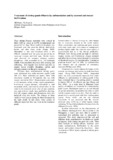Treatment of shrimp pond effluents by sedimentation and by seaweed and mussel biofiltration
- Global styles
- MLA
- Vancouver
- Elsevier - Harvard
- APA
- Help

View/
Date
2007Page views
6,563ASFA keyword
AGROVOC keyword
Taxonomic term
Metadata
Show full item record
Share
Abstract
Tiger shrimp Penaeus monodon were stocked in three 1,000 m2 ponds at 12,000 juveniles/pond and grown for 141 days. Water quality in the ponds was monitored over the grow-out period, particularly before and after every water change. BOD, chlorophyll a, and total dissolved solids of the effluent increased over the grow-out period due to increased biomass and feed input. Similar trends were observed for inorganic nitrogen, reactive phosphorus, total suspended solids, and hydrogen sulfide. Concentrations decreased after draining and reflooding. Soil samples also showed increases in organic matter available phosphate, carbon, and nitrogen content over the grow-out period.
Effluents from semi-intensive shrimp ponds were discharged into eight treatment ponds (each 200 m2): three sedimentation ponds, three with Gracilaria stocked at 20 kg/pond, and two with mussels stocked at 10/m2. Measurements were made of pH, ammonia, nitrite, nitrate, reactive phosphorus, biochemical oxygen demand, chlorophyll a, total suspended solids, and total dissolved solids in the water in the treatment ponds after effluent addition, one week and two weeks later, and before draining. Soil pH, organic matter, and phosphorus were also analyzed every two weeks. The changes in these variables were similar among the three treatments in the eight ponds. In this study, water quality of effluents improved after one week in the treatment ponds.
Suggested Citation
Fortes, N. R., & Corre Jr., V. L. (2007). Treatment of shrimp pond effluents by sedimentation and by seaweed and mussel biofiltration. In T. U. Bagarinao (Ed.), Research Output of the Fisheries Sector Program (Vol. 2. Reports on Fisheries and Aquaculture, pp. 109-113). Quezon City, Philippines: Bureau of Agricultural Research, Department of Agriculture.
Type
Book chapterISBN
9718511776


